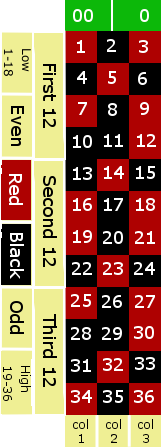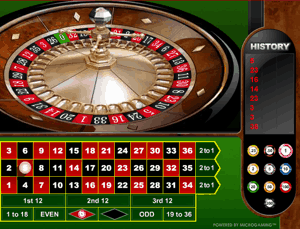Thread Rating:
I'm currently researching some roulette data. I would like to know how I can calculate the expected number of times a sequence of red comes up. So for example, in 1500 roulette spins, how often do I expect a sequence of 2 reds in a row to come up, how often do I expect a sequence of three reds in a row to come up and so on. Hope somebody can help me with that.
Cheers,
Peter
Administrator
- This is a question regarding fixed odds betting. If you say that the odds are 4 to 1 on something happening, then is that equivalent to saying the probability is 1 in 4 i.e. If you consistently bet on 4 to 1 shots would you simply break even over time?
- The chance of red four times in a row is 5.6% but if you come to the table immediately after a red number has appeared, the probability that you will witness a further three reds (making a total of four times in a row) is 11.5% – purely because you will be observing only a series of three rounds.
- The following chart highlights the probabilities of the same colour appearing over a certain number of spins of the roulette wheel. Example: The probability of the same colour showing up 4 times in a row is 5.6%. A graph to show the probability of seeing the same colour of red/black (or any 'evens' bet result for that matter) over multiple spins.
In 1500 spins, there are 1499 possible pairs of spins
The odds that the colour red will hit three times in a row is 48.6% x 48.6% x 48.6% = 11.4%.
For any pair of spins, the chances of both coming up red is (18/38) * (18/38) or 0.2243767313 assuming double zero wheel.
So you can expect to see 2 consecutive reds 1499 * 0.2243767313 times or 336 times.
Of course a sequence of 3 reds is treated as two sequences of 2
If you want to work it out for sequences of 3, then..
In 1500 spins, there are 1498 possible triplets of spins
For any triplet of spins, the chances of all three coming up red is (18/38) * (18/38) * (18/38) or 0.10628371482 assuming double zero wheel.
So you can expect to see 3 consecutive reds 1498 * 0.10628371482 times or 159 times.
Of course a sequence of 5 reds is treated as three sequences of 3.
Meanwhile.. Remember, you don't have a winning system. You never will. :o)
Poker tournaments medicine hat. Hi,
I'm currently researching some roulette data. I would like to know how I can calculate the expected number of times a sequence of red comes up. So for example, in 1500 roulette spins, how often do I expect a sequence of 2 reds in a row to come up, how often do I expect a sequence of three reds in a row to come up and so on. Hope somebody can help me with that.
Cheers,
Peter
Don't worry about it, and move onto your next project. Your idea won't beat roulette.
Zero, since you are counting how many times red comes up exactly twice in a row?
One?
Two, since it is 'two pairs of reds' (1 & 2, 3 & 4)?
Four, since spins 1 & 2 are consecutive, as are 2 & 3, 3 & 4, and 4 & 5?
But as SM777 has pointed out, if you are looking for some mysterious way to beat roulette, don't bother. Remember, after two (or four, or 257, or zero) consecutive reds, the probability that the next spin will be red on a double-zero wheel is still 9/19 (and black is 9/19, and green is 1/19).
Acrylic poker chip case 500. I would like to know how I can calculate the expected number of times a sequence of red comes up.


2 totally different animals
*****
for 3 or more run (in Excel for example)
parameters:
p=(18/38)
length=3
trials=1500

THE FORMULA (without proof - that is internet stuff)
=(p^length)*(1+((trials-length)*q))
for exactly length of 3
calculate 4 and 3
Roulette Odds 4 Reds In A Row 4
subtract 4 from 3here is my Excel in Google if want to see (easy)
https://goo.gl/98yjKp
So for example, in 1500 roulette spins,
how often do I expect a sequence of 2 reds in a row to come up,
how often do I expect a sequence of three reds in a row to come up and so on.

just remember dealing with averages or expected numbers is not the same as the probability.
2 totally different animals
*****
for 3 or more run (in Excel for example)
parameters:
p=(18/38)
length=3
trials=1500
q=(20/38)
THE FORMULA (without proof - that is internet stuff)
=(p^length)*(1+((trials-length)*q))
for exactly length of 3
calculate 4 and 3
Roulette Odds 4 Reds In A Row 4
subtract 4 from 3here is my Excel in Google if want to see (easy)
https://goo.gl/98yjKp
So for example, in 1500 roulette spins,
how often do I expect a sequence of 2 reds in a row to come up,
how often do I expect a sequence of three reds in a row to come up and so on.
I simulated this 1 million times (1 million sets of 1500 spins)
and calculated it also (rounded to 4 decimals)
super close I do say
| . | sim | sim | sim | calc | calc | . |
|---|---|---|---|---|---|---|
| length | freq | exact 3 | 3 or more | expected # | exact 3 | length |
| 1 | 197014850 | 197.0149 | 374.1835 | 374.1856 | 197.0579 | 1 |
| 2 | 93283735 | 93.2837 | 177.1686 | 177.1277 | 93.2811 | 2 |
| 3 | 44168570 | 44.1686 | 83.8849 | 83.8467 | 44.1563 | 3 |
| 4 | 20912156 | 20.9122 | 39.7163 | 39.6903 | 20.9022 | 4 |
| 5 | 9898616 | 9.8986 | 18.8042 | 18.7881 | 9.8944 | 5 |
| 6 | 4689428 | 4.6894 | 8.9056 | 8.8937 | 4.6837 | 6 |
| 7 | 2217719 | 2.2177 | 4.2161 | 4.2100 | 2.2171 | 7 |
| 8 | 1050869 | 1.0509 | 1.9984 | 1.9929 | 1.0495 | 8 |
| 9 | 498950 | 0.4990 | 0.9475 | 0.9434 | 0.4968 | 9 |
| 10 | 236031 | 0.2360 | 0.4486 | 0.4466 | 0.2352 | 10 |
| 11 | 111977 | 0.1120 | 0.2126 | 0.2114 | 0.1113 | 11 |
| 12 | 53159 | 0.0532 | 0.1006 | 0.1001 | 0.0527 | 12 |
| 13 | 25012 | 0.0250 | 0.0474 | 0.0474 | 0.0249 | 13 |
| 14 | 11900 | 0.0119 | 0.0224 | 0.0224 | 0.0118 | 14 |
| 15 | 5520 | 0.0055 | 0.0105 | 0.0106 | 0.0056 | 15 |
| 16 | 2602 | 0.0026 | 0.0050 | 0.0050 | 0.0026 | 16 |
| 17 | 1232 | 0.0012 | 0.0024 | 0.0024 | 0.0013 | 17 |
| 18 | 613 | 0.0006 | 0.0012 | 0.0011 | 0.0006 | 18 |
| 19 | 272 | 0.0003 | 0.0005 | 0.0005 | 0.0003 | 19 |
| 20 | 140 | 0.0001 | 0.0003 | 0.0003 | 0.0001 | 20 |
| 21 | 59 | 0.0001 | 0.0001 | 0.0001 | 0.0001 | 21 |
| 22 | 30 | 0.0000 | 0.0001 | 0.0001 | 0.0000 | 22 |
| 23 | 20 | 0.0000 | 0.0000 | 0.0000 | 0.0000 | 23 |
| 24 | 11 | 0.0000 | 0.0000 | 0.0000 | 0.0000 | 24 |
| 25 | 5 | 0.0000 | 0.0000 | 0.0000 | 0.0000 | 25 |
| 26 | 5 | 0.0000 | 0.0000 | 0.0000 | 0.0000 | 26 |
| 27 | 0 | 0.0000 | 0.0000 | 0.0000 | 0.0000 | 27 |
| 28 | 0 | 0.0000 | 0.0000 | 0.0000 | 0.0000 | 28 |
| 29 | 1 | 0.0000 | 0.0000 | 0.0000 | 0.0000 | 29 |
have fun
hope this helps some(sum)
Sally
I guess I wasn't totally clear: I'm looking for 'exactly two in a row', 'exactly three in a row', etc. So a series of four reds in a row will be counted as just that, four in a row. Looks like the best way is to start with 1500 in a row (in a sample size of 1500) and calculate 1499 in a row as suggested with substracting 1500 in a row and work my way down to one.
Or apparently using the below formula. Could you point me in the right direction for the proof? I haven't been able to find anything about this subject on the web, hence I got here.
THE FORMULA (without proof - that is internet stuff)
=(p^length)*(1+((trials-length)*q))
Thanks,
Best Odds For Roulette
PeterAt least it would be easier to turn into percentages.
Russ
